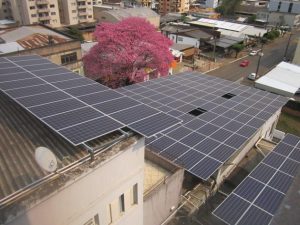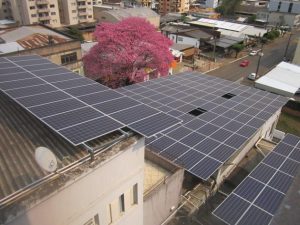Distributed Generation Provides Hope of Energy for the Poor in Brazil
 29 Oktober 2020
29 Oktober 2020

A hotel in Xanxerê, in the western part of the southern Brazilian state of Santa Catarina, took advantage of its rooftops to generate its own solar energy and save on electricity costs. Similar initiatives have taken place in other states of the country, such as the northeastern state of Paraíba, where solar power self-generation facilities are mushrooming in the capital, Sousa. CREDIT: Mario Osava/IPS
By Mario Osava
RÍO DE JANEIRO, Oct 28 2020 (IPS)
“Showing solidarity is consuming the energy generated in your own municipality” – this is the motto of a project of distributed electricity generation in one of Brazil’s many poor neighbourhoods.
“Sertão (the word for the country’s semiarid hinterland) with solidarity” is how the director of the Brazilian Association of Distributed Generation (ABGD) in the southeastern state of Minas Gerais, Walter Abreu, named the project. The organisation promotes solar energy in the north of that state, where 1.5 million of the state’s 2.7 million people live in poverty and half of these in extreme poverty.
If local governments were to decide to use solar panels to generate the electricity consumed by their offices and other facilities, this would represent significant savings in public spending and incomes comparable to a minimum wage (about 200 dollars per month) for 3,500 families, estimated Abreu in an interview with Solar TV, a channel that advocates the use of solar power.
Another estimate he provided is that increasing the proportion of solar energy in the national electricity grid to five percent could lift out of poverty two million people in Brazil’s semiarid Northeast, a region of 27 million people that experienced its longest drought between 2011 and 2018.
Distributed or decentralised generation is seen as an important means of giving a social boost to poor or energy-poor communities in different parts of this country, where 23.7 million people out of a total population of 212 million live in poverty.
The expansion of decentralised generation is part of a broader transition in several sectors, such as decarbonisation in response to requirements for combating climate change, the breakdown of monopolies and empowerment of consumers to become “prosumers” – both producers and consumers at the same time.

Carlos Evangelista, president of the Brazilian Association of Distributed Generation, explained to IPS that Brazil already has more than 400,000 “prosumer” plants for electricity from renewable sources, mainly solar. The growth and diversification of this type of generation is part of a global trend. CREDIT: Courtesy of ABGD
In this process, solar energy plays a leading role, “as the source that is growing the fastest and generating the most jobs,” Carlos Evangelista, president of ABGD, told IPS by phone from São Paulo.
In addition, 57 percent of these jobs in Brazil arise from the installation of the solar power systems, i.e., they are local, not distant or foreign, such as jobs involved in the manufacture and sales of the equipment, he pointed out.
The isolated solar energy systems in many communities in the Amazon rainforest, far from the electricity grid, produce perhaps the most outstanding effects.
They are used to pump water and to run refrigerators to preserve fish, the main local source of protein, other foods and exportable forest products, such as açaí, the fruit of a palm tree of the same name (Euterpe oleracea).
In general, scattered villages and hamlets in the jungle have diesel or gasoline generators, which only operate a few hours at night, due to the high cost of fuel and its scarcity. Fuel takes days to bring in by river boat.
ABGD, with support from the U.S.-based Charles Stewart Mott Foundation, promotes policies and projects together with more than sixty municipalities in the Amazon jungle in northern Brazil, with the aim of “mobilising resources for an economy that makes the transition from fossil fuels to renewables, and solar energy is one of the solutions,” said Evangelista.
“Four projects were completed in the Purus River basin,” with the installation of micro solar plants and the training of local technicians for the installation and maintenance of the equipment, the involvement of local leaders and the community, in order to “create a self-propelled economic ecosystem,” he said.
The COVID-19 pandemic interrupted the activities of the two-year project, but ABGD’s new director of sustainability and social action, Lucia Abadia, announced for the near future the larger “Divine Light” project, which would create 150 community micro solar plants.

This housing complex for a thousand poor families in Juazeiro, in the Northeastern Brazilian state of Bahia, was built at the beginning of the last decade with 9,144 solar panels to generate electricity for self-consumption and sell the surplus. In 2016, the monthly payment of about 18 dollars to each resident was suspended because the project did not meet all the requirements for distributed generation. CREDIT: Mario Osava/IPS
“The people in the Amazon need energy for their daily tasks and for starting businesses, producing, freezing and storing food, and thus living better while preserving the forests, without burning firewood,” she told IPS from Paulinia, 120 km from São Paulo.
Abadia “discovered” solar energy in her previous business activity, construction, when she was looking for solutions to develop “smart neighborhoods”, where she wanted to incorporate energy alternatives.
She then joined a solar system installation company which led her to ABGD, where she became director of sustainability, an unremunerated volunteer position.
In the Amazon, there are still 990,000 Brazilians without electricity, including indigenous people on reservations, riverbank dwellers, small farmers and people who live in environmental conservation areas, according to a study by the non-governmental Institute of Energy and Environment, in São Paulo.
In order to mobilise municipal authorities, the private sector and community leaders, ABGD is preparing a manual on public policies for the Amazon, which details the potential of distributed generation to bolster the local economy by generating jobs and social improvements.
Evangelista said: “We want to bring information to the local governments, about national and state public policies with which authorities in the interior are sometimes unfamiliar, such as the possibility of stimulating local energy generation with measures like tax reduction.”
It’s a process of transition, of a change in mentality that requires planning and takes time, he said. Many apparently well-designed projects have failed in the Amazon because they did not take into account local specificities, he added.

Lucia Abadia, director of sustainability in the Brazilian Association of Distributed Generation and executive director of Yellow Energía Solar, aims to promote 150 micro solar plants in remote communities in the Amazon rainforest, to improve the quality of life for local residents and boost local development. CREDIT: Courtesy of ABGD
There are also embedded interests, such as the fuel business.
“I received death threats for going against the diesel fuel distribution chain,” said Evangelista, an engineer whose interest in distributed generation was awakened when he had to secure power for telecommunication antennas while working for a transnational company.
In 2015 he founded ABGD with the participation of 14 companies from the power industry, involved in various services, production or sources. Today there are more than 800 associates.
The government also took a new stance on the energy exclusion experienced by many communities in the Amazon. In February, it launched the “More Light for the Amazon” programme, but with a limited goal of bringing solar energy to 70,000 families (a total of some 300,000 people).
But decentralised electricity generation as a factor in local social and economic development is also a concern in the Northeast, another poor region of Brazil.
“The Northeast concentrates 65 percent of the installed capacity of centralised solar energy, but only 18 percent of distributed generation,” said Daniel Lima, president of the Northeast Association of Solar Energy (Anesolar), founded in August, and director of the solar energy company RDSol.
“The state of Minas Gerais installed more power in solar distributed generation than the nine states of the Northeast,” he noted.
The difference lies in the tax exemption that Minas Gerais has been offering for the past five years, an initiative only followed by the state of Rio de Janeiro, starting in July of this year. Anesolar will demand that the governments of the Northeastern states adopt a similar measure.
Centralised generation, generally on solar farms, grew a great deal because of the low price of land in the Northeast, compared to other regions, Lima explained. The difficulty that consumers run into with regard to finding financing is another barrier to their becoming “prosumers”, he added.
Even so, there are cases of successful projects, such as that of the Cabedelo School of Medicine, in the state of Paraíba, which took advantage of its parking lot with 300 parking spaces and covered it with solar panels. The energy generated allowed it to save 90 percent of its electrical expenses – about 11,000 dollars per month.
The major incentive for people to become prosumers is the unsustainable increase in the price of electricity, which for more than a decade has been rising more than inflation, the result of subsidies to various sectors and activities whose cost is charged to energy consumers, Lima said by telephone from a town in Alagoas, a neighbouring state where he has been living during the COVID-19 crisis.
There is still very little distributed generation in Brazil, but it is growing rapidly. It rose twofold from one to two gigawatts between June and December 2019 and reached three GW in May 2020, according to the Energy Research Company, a planning body under the Ministry of Mines and Energy.
The post Distributed Generation Provides Hope of Energy for the Poor in Brazil appeared first on Inter Press Service.
